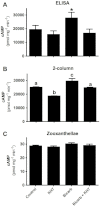High adenylyl cyclase activity and in vivo cAMP fluctuations in corals suggest central physiological role
- PMID: 23459251
- PMCID: PMC3587883
- DOI: 10.1038/srep01379
High adenylyl cyclase activity and in vivo cAMP fluctuations in corals suggest central physiological role
Abstract
Corals are an ecologically and evolutionarily significant group, providing the framework for coral reef biodiversity while representing one of the most basal of metazoan phyla. However, little is known about fundamental signaling pathways in corals. Here we investigate the dynamics of cAMP, a conserved signaling molecule that can regulate virtually every physiological process. Bioinformatics revealed corals have both transmembrane and soluble adenylyl cyclases (AC). Endogenous cAMP levels in live corals followed a potential diel cycle, as they were higher during the day compared to the middle of the night. Coral homogenates exhibited some of the highest cAMP production rates ever to be recorded in any organism; this activity was inhibited by calcium ions and stimulated by bicarbonate. In contrast, zooxanthellae or mucus had >1000-fold lower AC activity. These results suggest that cAMP is an important regulator of coral physiology, especially in response to light, acid/base disturbances and inorganic carbon levels.
Figures





Similar articles
-
Identification of a molecular pH sensor in coral.Proc Biol Sci. 2017 Nov 15;284(1866):20171769. doi: 10.1098/rspb.2017.1769. Proc Biol Sci. 2017. PMID: 29093223 Free PMC article.
-
Molecular mechanisms of sperm motility are conserved in an early-branching metazoan.Proc Natl Acad Sci U S A. 2021 Nov 30;118(48):e2109993118. doi: 10.1073/pnas.2109993118. Proc Natl Acad Sci U S A. 2021. PMID: 34810263 Free PMC article.
-
Regulation of coral calcification by the acid-base sensing enzyme soluble adenylyl cyclase.Biochem Biophys Res Commun. 2020 May 7;525(3):576-580. doi: 10.1016/j.bbrc.2020.02.115. Epub 2020 Feb 27. Biochem Biophys Res Commun. 2020. PMID: 32115151
-
CO(2)/HCO(3)(-)-responsive soluble adenylyl cyclase as a putative metabolic sensor.Trends Endocrinol Metab. 2001 Oct;12(8):366-70. doi: 10.1016/s1043-2760(01)00454-4. Trends Endocrinol Metab. 2001. PMID: 11551811 Review.
-
Central role of soluble adenylyl cyclase and cAMP in sperm physiology.Biochim Biophys Acta. 2014 Dec;1842(12 Pt B):2610-20. doi: 10.1016/j.bbadis.2014.07.013. Epub 2014 Jul 24. Biochim Biophys Acta. 2014. PMID: 25066614 Free PMC article. Review.
Cited by
-
Identification of a molecular pH sensor in coral.Proc Biol Sci. 2017 Nov 15;284(1866):20171769. doi: 10.1098/rspb.2017.1769. Proc Biol Sci. 2017. PMID: 29093223 Free PMC article.
-
Dynamic regulation of coral energy metabolism throughout the diel cycle.Sci Rep. 2020 Nov 16;10(1):19881. doi: 10.1038/s41598-020-76828-2. Sci Rep. 2020. PMID: 33199772 Free PMC article.
-
Established and potential physiological roles of bicarbonate-sensing soluble adenylyl cyclase (sAC) in aquatic animals.J Exp Biol. 2014 Mar 1;217(Pt 5):663-72. doi: 10.1242/jeb.086157. J Exp Biol. 2014. PMID: 24574382 Free PMC article. Review.
-
Conservation of Protein Kinase A Substrates in the Cnidarian Coral Spermatozoa Among Animals and Their Molecular Evolution.J Mol Evol. 2024 Jun;92(3):217-257. doi: 10.1007/s00239-024-10168-x. Epub 2024 Apr 25. J Mol Evol. 2024. PMID: 38662235
-
Bicarbonate Inhibits Bacterial Growth and Biofilm Formation of Prevalent Cystic Fibrosis Pathogens.Front Microbiol. 2018 Sep 19;9:2245. doi: 10.3389/fmicb.2018.02245. eCollection 2018. Front Microbiol. 2018. PMID: 30283433 Free PMC article.
References
-
- Knowlton N. et al. in Life in the World's Oceans: Diversity, Distribution, and Abundance 65–77 (John Wiley and Sons, 2010).
-
- Hoegh-Guldberg O. et al. Coral reefs under rapid climate change and ocean acidification. Science 318, 1737–1742 (2007). - PubMed
-
- Technau U. et al. Maintenance of ancestral complexity and non-metazoan genes in two basal cnidarians. Trends Genet 21, 633–639 (2005). - PubMed
Publication types
MeSH terms
Substances
Grants and funding
LinkOut - more resources
Full Text Sources
Other Literature Sources

